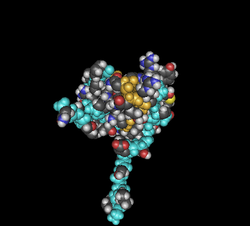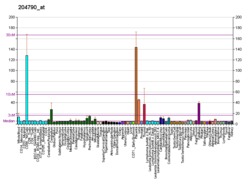SMAD7
SMAD7(SMAD family member 7)は、ヒトではSMAD7遺伝子にコードされるタンパク質である[5]。
構造
[編集]Smadタンパク質には2つの保存されたドメイン、N末端のMH1(Mad homology 1)ドメインとC末端のMH2(Mad homology 2)ドメインが存在する。両者の間にはリンカー領域が存在し、そこには多くの調節部位が位置している。MH1ドメインはDNA結合活性を有するのに対し、MH2ドメインは転写活性化能を有する[6]。リンカー領域には、MAPK[7]やCaMKII[8]、PKC[9]によるリン酸化部位など、重要な調節モチーフが含まれている。SMAD7にはMH1ドメインは存在せず、リンカー領域に存在するプロリン-チロシン(PY)モチーフはE3ユビキチンリガーゼであるSMURF2のWWドメインとの相互作用を可能にしている。SMAD7は基底状態では主に核内に位置し、TGF-β刺激に伴って細胞質へ移行する[10]。
機能
[編集]SMAD7は、TGF-βシグナルの伝達を開始するSMAD2/SMAD4複合体の形成を妨げることで、シグナル伝達を阻害する。SMAD7は活性化されたTGF-β I型受容体と相互作用し、SMAD2の結合、リン酸化そして活性化を遮断する[11]。また、アクチビンやBMPに対するI型受容体にも結合し、これらの経路においてもネガティブフィードバックとしての機能を果たしている[12][13]。
TGF-β処理に伴って、SMAD7はMH2ドメインを介してPellino-1へ結合する。この相互作用はIRAK1を介したIL-1R/TLRシグナル伝達複合体の形成を遮断してNF-κB活性を抑制し、炎症促進遺伝子の発現の低下を引き起こす[14]。
SMAD7はTGF-βによって誘導されるが、EGF、IFN-γ、TNF-αなど他の刺激によっても誘導される。そのため、SMAD7はTGF-βシグナルとその他のシグナル伝達経路の間のクロストークをもたらす[15]。
がんにおける役割
[編集]SMAD7遺伝子の変異は大腸がんの感受性の原因となる[16]。大腸がんではSMAD7のアップレギュレーションとTGF-βシグナルの抑制が生じている[17]。アジア・ヨーロッパ集団を対象とした症例対照研究やメタアナリシスにおいても、SMAD7の変異と大腸がんリスクとの関連が示されている[18]。
TGF-βは膵がんにおける重要な成長因子の1つである。SMAD7はTGF-β経路を制御することで、この疾患と関係していると考えられている。膵がん細胞におけるSMAD7の過剰発現を示す研究も低発現を示す研究もあり、膵がんにおけるSMAD7の役割に関してはいまだ議論がある[19][20][21][22]。
上皮成長因子受容体(EGFR)の過剰発現または恒常的活性化は、腫瘍過程を促進する[23][24]。EGFによって誘導されるMMP-9の発現は、乳がんや卵巣がんなど一部の腫瘍細胞の浸潤と転移を促進する[25][26]。SMAD7はEGFシグナル伝達経路に対して阻害的効果を示すため、がんの転移の防止に関与している可能性がある[27]。
相互作用
[編集]SMAD7は次に挙げる因子と相互作用することが示されている。
- CTNNB1[28]
- EP300[29]
- TAB1[30][31]
- PIAS4[32]
- RNF111[33]
- SMAD3[34][35]
- SMAD6[36]
- SMURF2[37][38][39]
- STRAP[34]
- TGFBR1[11][33][34][37][38][40]
- YAP1[41]
出典
[編集]- ^ a b c GRCh38: Ensembl release 89: ENSG00000101665 - Ensembl, May 2017
- ^ a b c GRCm38: Ensembl release 89: ENSMUSG00000025880 - Ensembl, May 2017
- ^ Human PubMed Reference:
- ^ Mouse PubMed Reference:
- ^ “SMAD7 SMAD family member 7 [Homo sapiens (human) - Gene - NCBI]”. www.ncbi.nlm.nih.gov. 2024年4月23日閲覧。
- ^ Shi Y, Hata A, Lo RS, Massagué J, Pavletich NP (July 1997). “A structural basis for mutational inactivation of the tumour suppressor Smad4”. Nature 388 (6637): 87–93. Bibcode: 1997Natur.388R..87S. doi:10.1038/40431. PMID 9214508.
- ^ Kretzschmar M, Doody J, Massagué J (October 1997). “Opposing BMP and EGF signalling pathways converge on the TGF-beta family mediator Smad1”. Nature 389 (6651): 618–622. Bibcode: 1997Natur.389..618K. doi:10.1038/39348. PMID 9335504.
- ^ Wicks SJ, Lui S, Abdel-Wahab N, Mason RM, Chantry A (November 2000). “Inactivation of smad-transforming growth factor beta signaling by Ca(2+)-calmodulin-dependent protein kinase II”. Mol. Cell. Biol. 20 (21): 8103–8111. doi:10.1128/MCB.20.21.8103-8111.2000. PMC 86420. PMID 11027280.
- ^ Yakymovych I, Ten Dijke P, Heldin CH, Souchelnytskyi S (March 2001). “Regulation of Smad signaling by protein kinase C”. FASEB J. 15 (3): 553–555. doi:10.1096/fj.00-0474fje. PMID 11259364.
- ^ Itóh S, Landström M, Hermansson A, Itoh F, Heldin CH, Heldin NE, ten Dijke P (October 1998). “Transforming growth factor beta1 induces nuclear export of inhibitory Smad7”. J. Biol. Chem. 273 (44): 29195–29201. doi:10.1074/jbc.273.44.29195. PMID 9786930.
- ^ a b Hayashi H, Abdollah S, Qiu Y, Cai J, Xu YY, Grinnell BW, Richardson MA, Topper JN, Gimbrone MA, Wrana JL, Falb D (June 1997). “The MAD-related protein Smad7 associates with the TGFbeta receptor and functions as an antagonist of TGFbeta signaling”. Cell 89 (7): 1165–1173. doi:10.1016/S0092-8674(00)80303-7. PMID 9215638.
- ^ Ishisaki A, Yamato K, Hashimoto S, Nakao A, Tamaki K, Nonaka K, ten Dijke P, Sugino H, Nishihara T (May 1999). “Differential inhibition of Smad6 and Smad7 on bone morphogenetic protein- and activin-mediated growth arrest and apoptosis in B cells”. J. Biol. Chem. 274 (19): 13637–13642. doi:10.1074/jbc.274.19.13637. PMID 10224135.
- ^ Nakao A, Afrakhte M, Morén A, Nakayama T, Christian JL, Heuchel R, Itoh S, Kawabata M, Heldin NE, Heldin CH, ten Dijke P (October 1997). “Identification of Smad7, a TGFbeta-inducible antagonist of TGF-β signalling”. Nature 389 (6651): 631–635. Bibcode: 1997Natur.389..631N. doi:10.1038/39369. PMID 9335507.
- ^ Lee YS, Kim JH, Kim ST, Kwon JY, Hong S, Kim SJ, Park SH (March 2010). “Smad7 and Smad6 bind to discrete regions of Pellino-1 via their MH2 domains to mediate TGF-beta1-induced negative regulation of IL-1R/TLR signaling”. Biochem. Biophys. Res. Commun. 393 (4): 836–843. doi:10.1016/j.bbrc.2010.02.094. PMID 20171181.
- ^ Bitzer M, von Gersdorff G, Liang D, Dominguez-Rosales A, Beg AA, Rojkind M, Böttinger EP (January 2000). “A mechanism of suppression of TGF-beta/SMAD signaling by NF-kappa B/RelA”. Genes Dev. 14 (2): 187–197. doi:10.1101/gad.14.2.187. PMC 316349. PMID 10652273.
- ^ “Entry - #612229 - COLORECTAL CANCER, SUSCEPTIBILITY TO, 3; CRCS3 - OMIM”. www.omim.org. 2024年4月26日閲覧。
- ^ Halder SK, Rachakonda G, Deane NG, Datta PK (September 2008). “Smad7 induces hepatic metastasis in colorectal cancer”. Br. J. Cancer 99 (6): 957–965. doi:10.1038/sj.bjc.6604562. PMC 2538763. PMID 18781153.
- ^ Song Q, Zhu B, Hu W, Cheng L, Gong H, Xu B, Zheng X, Zou L, Zhong R, Duan S, Chen W, Rui R, Wu J, Miao X (2012). Peterlongo, Paolo. ed. “A common SMAD7 variant is associated with risk of colorectal cancer: evidence from a case-control study and a meta-analysis”. PLOS ONE 7 (3): e33318. Bibcode: 2012PLoSO...733318S. doi:10.1371/journal.pone.0033318. PMC 3310071. PMID 22457752.
- ^ Singh P, Wig JD, Srinivasan R (2011). “The Smad family and its role in pancreatic cancer”. Indian J Cancer 48 (3): 351–360. doi:10.4103/0019-509X.84939. PMID 21921337.
- ^ Kleeff J, Ishiwata T, Maruyama H, Friess H, Truong P, Büchler MW, Falb D, Korc M (September 1999). “The TGF-beta signaling inhibitor Smad7 enhances tumorigenicity in pancreatic cancer”. Oncogene 18 (39): 5363–5372. doi:10.1038/sj.onc.1202909. PMID 10498890.
- ^ Guo J, Kleeff J, Zhao Y, Li J, Giese T, Esposito I, Büchler MW, Korc M, Friess H (May 2006). “Yes-associated protein (YAP65) in relation to Smad7 expression in human pancreatic ductal adenocarcinoma”. Int. J. Mol. Med. 17 (5): 761–767. doi:10.3892/ijmm.17.5.761. PMID 16596258.
- ^ Arnold NB, Ketterer K, Kleeff J, Friess H, Büchler MW, Korc M (May 2004). “Thioredoxin is downstream of Smad7 in a pathway that promotes growth and suppresses cisplatin-induced apoptosis in pancreatic cancer”. Cancer Res. 64 (10): 3599–3606. doi:10.1158/0008-5472.CAN-03-2999. PMID 15150118.
- ^ Salomon DS, Brandt R, Ciardiello F, Normanno N (July 1995). “Epidermal growth factor-related peptides and their receptors in human malignancies”. Crit. Rev. Oncol. Hematol. 19 (3): 183–232. doi:10.1016/1040-8428(94)00144-I. PMID 7612182.
- ^ Burgess AW, Cho HS, Eigenbrot C, Ferguson KM, Garrett TP, Leahy DJ, Lemmon MA, Sliwkowski MX, Ward CW, Yokoyama S (September 2003). “An open-and-shut case? Recent insights into the activation of EGF/ErbB receptors”. Mol. Cell 12 (3): 541–552. doi:10.1016/S1097-2765(03)00350-2. PMID 14527402.
- ^ Kim S, Choi JH, Lim HI, Lee SK, Kim WW, Cho S, Kim JS, Kim JH, Choe JH, Nam SJ, Lee JE, Yang JH (June 2009). “EGF-induced MMP-9 expression is mediated by the JAK3/ERK pathway, but not by the JAK3/STAT-3 pathway in a SKBR3 breast cancer cell line”. Cell. Signal. 21 (6): 892–898. doi:10.1016/j.cellsig.2009.01.034. PMID 19385051.
- ^ Ellerbroek SM, Hudson LG, Stack MS (October 1998). “Proteinase requirements of epidermal growth factor-induced ovarian cancer cell invasion”. Int. J. Cancer 78 (3): 331–337. doi:10.1002/(SICI)1097-0215(19981029)78:3<331::AID-IJC13>3.0.CO;2-9. PMID 9766568.
- ^ Kim S, Han J, Lee SK, Koo M, Cho DH, Bae SY, Choi MY, Kim JS, Kim JH, Choe JH, Yang JH, Nam SJ, Lee JE (January 2012). “Smad7 acts as a negative regulator of the epidermal growth factor (EGF) signaling pathway in breast cancer cells”. Cancer Lett. 314 (2): 147–154. doi:10.1016/j.canlet.2011.09.024. PMID 22033246.
- ^ Edlund S, Lee SY, Grimsby S, Zhang S, Aspenström P, Heldin CH, Landström M (February 2005). “Interaction between Smad7 and beta-catenin: importance for transforming growth factor beta-induced apoptosis”. Mol. Cell. Biol. 25 (4): 1475–1488. doi:10.1128/MCB.25.4.1475-1488.2005. PMC 548008. PMID 15684397.
- ^ Grönroos E, Hellman U, Heldin CH, Ericsson J (September 2002). “Control of Smad7 stability by competition between acetylation and ubiquitination”. Mol. Cell 10 (3): 483–493. doi:10.1016/S1097-2765(02)00639-1. PMID 12408818.
- ^ Edlund S, Bu S, Schuster N, Aspenström P, Heuchel R, Heldin NE, ten Dijke P, Heldin CH, Landström M (February 2003). “Transforming growth factor-beta1 (TGF-beta)-induced apoptosis of prostate cancer cells involves Smad7-dependent activation of p38 by TGF-beta-activated kinase 1 and mitogen-activated protein kinase kinase 3”. Mol. Biol. Cell 14 (2): 529–544. doi:10.1091/mbc.02-03-0037. PMC 149990. PMID 12589052.
- ^ Yanagisawa M, Nakashima K, Takeda K, Ochiai W, Takizawa T, Ueno M, Takizawa M, Shibuya H, Taga T (December 2001). “Inhibition of BMP2-induced, TAK1 kinase-mediated neurite outgrowth by Smad6 and Smad7”. Genes Cells 6 (12): 1091–1099. doi:10.1046/j.1365-2443.2001.00483.x. PMID 11737269.
- ^ Imoto S, Sugiyama K, Muromoto R, Sato N, Yamamoto T, Matsuda T (September 2003). “Regulation of transforming growth factor-beta signaling by protein inhibitor of activated STAT, PIASy through Smad3”. J. Biol. Chem. 278 (36): 34253–34258. doi:10.1074/jbc.M304961200. hdl:2115/28123. PMID 12815042.
- ^ a b Koinuma D, Shinozaki M, Komuro A, Goto K, Saitoh M, Hanyu A, Ebina M, Nukiwa T, Miyazawa K, Imamura T, Miyazono K (December 2003). “Arkadia amplifies TGF-beta superfamily signalling through degradation of Smad7”. EMBO J. 22 (24): 6458–6470. doi:10.1093/emboj/cdg632. PMC 291827. PMID 14657019.
- ^ a b c Datta PK, Moses HL (May 2000). “STRAP and Smad7 synergize in the inhibition of transforming growth factor beta signaling”. Mol. Cell. Biol. 20 (9): 3157–3167. doi:10.1128/MCB.20.9.3157-3167.2000. PMC 85610. PMID 10757800.
- ^ Lebrun JJ, Takabe K, Chen Y, Vale W (January 1999). “Roles of pathway-specific and inhibitory Smads in activin receptor signaling”. Mol. Endocrinol. 13 (1): 15–23. doi:10.1210/mend.13.1.0218. PMID 9892009.
- ^ Topper JN, Cai J, Qiu Y, Anderson KR, Xu YY, Deeds JD, Feeley R, Gimeno CJ, Woolf EA, Tayber O, Mays GG, Sampson BA, Schoen FJ, Gimbrone MA, Falb D (August 1997). “Vascular MADs: two novel MAD-related genes selectively inducible by flow in human vascular endothelium”. Proc. Natl. Acad. Sci. U.S.A. 94 (17): 9314–9319. Bibcode: 1997PNAS...94.9314T. doi:10.1073/pnas.94.17.9314. PMC 23174. PMID 9256479.
- ^ a b Asano Y, Ihn H, Yamane K, Kubo M, Tamaki K (January 2004). “Impaired Smad7-Smurf-mediated negative regulation of TGF-beta signaling in scleroderma fibroblasts”. J. Clin. Invest. 113 (2): 253–264. doi:10.1172/JCI16269. PMC 310747. PMID 14722617.
- ^ a b Kavsak P, Rasmussen RK, Causing CG, Bonni S, Zhu H, Thomsen GH, Wrana JL (December 2000). “Smad7 binds to Smurf2 to form an E3 ubiquitin ligase that targets the TGF beta receptor for degradation”. Mol. Cell 6 (6): 1365–1375. doi:10.1016/S1097-2765(00)00134-9. PMID 11163210.
- ^ Lee YS, Han JM, Son SH, Choi JW, Jeon EJ, Bae SC, Park YI, Kim S (July 2008). “AIMP1/p43 downregulates TGF-beta signaling via stabilization of smurf2”. Biochem. Biophys. Res. Commun. 371 (3): 395–400. doi:10.1016/j.bbrc.2008.04.099. PMID 18448069.
- ^ Mochizuki T, Miyazaki H, Hara T, Furuya T, Imamura T, Watabe T, Miyazono K (July 2004). “Roles for the MH2 domain of Smad7 in the specific inhibition of transforming growth factor-beta superfamily signaling”. J. Biol. Chem. 279 (30): 31568–31574. doi:10.1074/jbc.M313977200. PMID 15148321.
- ^ Ferrigno O, Lallemand F, Verrecchia F, L'Hoste S, Camonis J, Atfi A, Mauviel A (July 2002). “Yes-associated protein (YAP65) interacts with Smad7 and potentiates its inhibitory activity against TGF-beta/Smad signaling”. Oncogene 21 (32): 4879–4884. doi:10.1038/sj.onc.1205623. PMID 12118366.
関連文献
[編集]- Massagué J (1998). “TGF-beta signal transduction”. Annu. Rev. Biochem. 67: 753–791. doi:10.1146/annurev.biochem.67.1.753. PMID 9759503.
- Verschueren K, Huylebroeck D (1999). “Remarkable versatility of Smad proteins in the nucleus of transforming growth factor-beta activated cells”. Cytokine Growth Factor Rev. 10 (3–4): 187–199. doi:10.1016/S1359-6101(99)00012-X. PMID 10647776.
- Wrana JL, Attisano L (2000). “The Smad pathway”. Cytokine Growth Factor Rev. 11 (1–2): 5–13. doi:10.1016/S1359-6101(99)00024-6. PMID 10708948.
- Miyazono K, ten Dijke P, Heldin CH (2000). “TGF-β signaling by Smad proteins”. Advances in Immunology Volume 75. 75. pp. 115–157. doi:10.1016/S0065-2776(00)75003-6. ISBN 9780120224753. PMID 10879283
- Hayashi H, Abdollah S, Qiu Y, Cai J, Xu YY, Grinnell BW, Richardson MA, Topper JN, Gimbrone MA, Wrana JL, Falb D (June 1997). “The MAD-related protein Smad7 associates with the TGFbeta receptor and functions as an antagonist of TGFbeta signaling”. Cell 89 (7): 1165–1173. doi:10.1016/S0092-8674(00)80303-7. PMID 9215638.
- Röijer E, Morén A, ten Dijke P, Stenman G (1998). “Assignment1 of the Smad7 gene (MADH7) to human chromosome 18q21.1 by fluorescence in situ hybridization”. Cytogenet. Cell Genet. 81 (3–4): 189–190. doi:10.1159/000015026. PMID 9730599.
- Denissova NG, Pouponnot C, Long J, He D, Liu F (June 2000). “Transforming growth factor beta -inducible independent binding of SMAD to the Smad7 promoter”. Proc. Natl. Acad. Sci. U.S.A. 97 (12): 6397–6402. Bibcode: 2000PNAS...97.6397D. doi:10.1073/pnas.090099297. PMC 18614. PMID 10823886.
- Stopa M, Anhuf D, Terstegen L, Gatsios P, Gressner AM, Dooley S (September 2000). “Participation of Smad2, Smad3, and Smad4 in transforming growth factor beta (TGF-beta)-induced activation of Smad7. THE TGF-beta response element of the promoter requires functional Smad binding element and E-box sequences for transcriptional regulation”. J. Biol. Chem. 275 (38): 29308–29317. doi:10.1074/jbc.M003282200. PMID 10887185.
- Ebisawa T, Fukuchi M, Murakami G, Chiba T, Tanaka K, Imamura T, Miyazono K (April 2001). “Smurf1 interacts with transforming growth factor-beta type I receptor through Smad7 and induces receptor degradation”. J. Biol. Chem. 276 (16): 12477–12480. doi:10.1074/jbc.C100008200. PMID 11278251.
- Itoh F, Asao H, Sugamura K, Heldin CH, ten Dijke P, Itoh S (August 2001). “Promoting bone morphogenetic protein signaling through negative regulation of inhibitory Smads”. EMBO J. 20 (15): 4132–4142. doi:10.1093/emboj/20.15.4132. PMC 149146. PMID 11483516.






